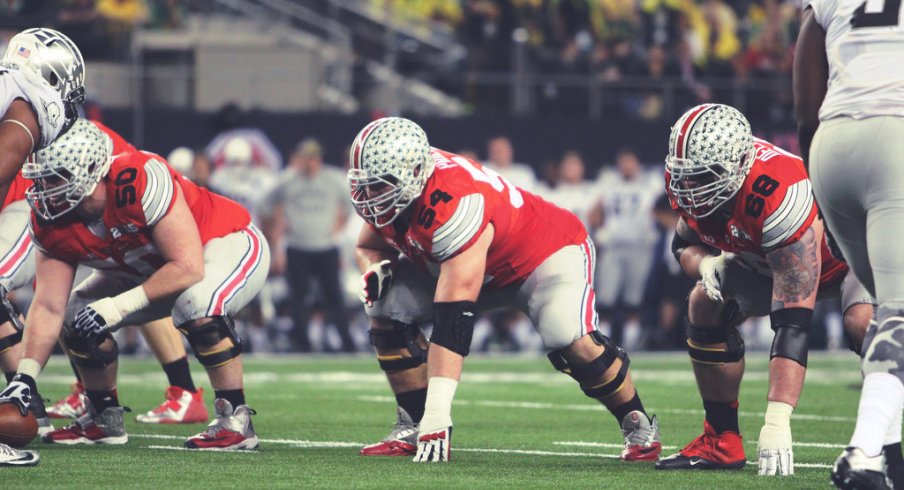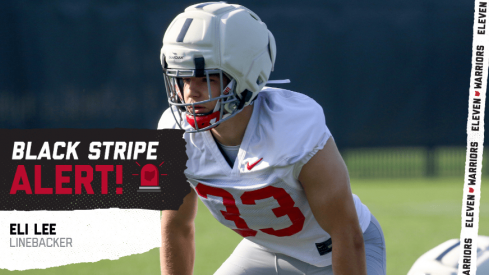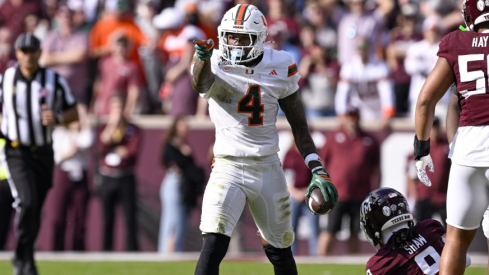The Hogs. The Electric Company. Offensive lines don't acquire as many nicknames as defenses, but the ones that do are memorable. Ohio State's Slobs are no different.
The name is the brainchild of Andrew Norwell, now the starting left guard for the Carolina Panthers. Norwell came up with the term in 2013, and the line began to use it as a bonding term, emphasizing how unrefined the group was as a whole.
At the start of 2014, the new Slobs had next to no experience. Taylor Decker had started 14 games as a sophomore; the rest of the line (left guard Billy Price, center Jacoby Boren, right guard Pat Elflein and right tackle Darryl Baldwin) had one start between them. The one man who could have provided multi-year experience, Alabama transfer Chad Lindsay, suffered a season-ending injury in August.
Two weeks into the season, the Slobs were a mess. Virginia Tech befuddled the line with stunts and twists, sacking poor J.T. Barrett seven times and hurrying him another 21 times. A kick in the seat was the motivation the line needed.
"I think you just have to be real with them," Decker said in September. "You can’t tell them things that aren’t true and you just have to be open and honest with them and tell them that type of play is not gonna be acceptable around here."
| Opponent | Car | Yds | YPC |
|---|---|---|---|
| Illinois | 44 | 296 | 6.7 |
| Michigan State | 41 | 268 | 6.5 |
| Minnesota | 38 | 289 | 7.6 |
| Indiana | 39 | 225 | 5.8 |
| Michigan | 39 | 233 | 6.0 |
| Wisconsin | 38 | 301 | 7.9 |
| Alabama | 42 | 281 | 6.7 |
| Oregon | 61 | 296 | 4.9 |
| AVERAGE | 43 | 274 | 6.4 |
Whether it was Decker or offensive line coach Ed Warinner who motivated the Slobs, they began to mesh. Over the last half of the season, from November onward, Ohio State's offensive line was unmatched.
Starting in November, Ohio State was a rushing terror. The Buckeyes rushed for 2,189 yards (best in the nation) for 6.4 yards per carry. The rushing attack was remarkably consistent, with 38 to 44 carries per game from Illinois to the Sugar Bowl.
Ohio State ran 61 times against Oregon for an average of 4.9 yards per carry. To a casual observer, it might seem like the offensive line dropped off in the championship game. Far from it.
Last summer, Eleven Warriors writer John Brandon devised Good Blocking Rate, a means to evaluate how often the offensive line sprung the running back for a decent gain. Against an average team, a solid line has a GBR around 60%. A very good line around 65%, an elite line around 70%. These percentages are lower against elite teams.
In three postseason games, the Slobs faced two elite defensive fronts (Wisconsin, Alabama) and an above average front (Oregon). The offensive line's GBR across these games was 65%. Mind you, the vaunted 2013 line only averaged 67% in the postseason.
| Rushing Attempts | Good Blocking | Good Blocking Rate (GBR) | |
|---|---|---|---|
| Wisconsin | 36 | 24 | 66.7% |
| Alabama | 34 | 21 | 61.8% |
| Oregon | 53 | 35 | 66.0% |
In a now prescient prediction, Brandon thought that fielding a good offensive line with castoffs in 2012 boded well for the spare parts of the 2014 line. Ohio State's 2013 line had a remarkable GSR of 74.9% for the year. Linsley, Mewhort, and Fragel were drafted; Linsley, Mewhort and Norwell all started in the NFL as rookies.
Those four are pros now, but their success would have been a surprise before 2012:
Consider the 2012 offensive line's success as well. [...] The 2012 line featured a center (Corey Linsley) that had never started a game, a left tackle (Jack Mewhort) who had never played tackle before, a right tackle (Reid Fragel) who was a tight end in the previous season. The "experienced" guy was Andrew Norwell, who started at left tackle for the first half of his sophomore season before moving inside.
Let's compare the 2012 line to the 2014 line. The 2014 line featured a center (Jacoby Boren) who had never started a game, a right guard (Pat Elflein) who only started because of two flipped birds, a left guard (Billy Price) who went from two-way high school lineman to redshirt freshman starter, and a right tackle (Darryl Baldwin) who converted to an offensive lineman as a senior. The "experienced" guy was Taylor Decker, who started at left tackle as a true sophomore.
With about as much experience as the 2012 offensive line, the 2014 line performed nearly as well in the three biggest games of the year. If one charted their performance across the entire season, it would likely be higher.
If the improvement of Ohio State's offensive line from 2012 to 2013 is any indication, the Slobs should be even better in 2015. Offensive lines improve with experience, particularly on the interior line. The only question is how much Ed Warinner, a decent offensive line coach, can get out of them.
"No matter how good or how bad we do, Coach Warinner is always pushing us. Him pushing us and each of us pushing each other on the line has made us closer and stronger as a unit," Jacoby Boren said before the national championship game. "Pretty much week in and week out, I feel we’ve gotten stronger and stronger and we take a lot of pride in performing well."
At the start of 2015, the Decker-Price-Boren-Elflein permutation will have 75 starts between them. They will have to cope with cognitive dissonance; it's hard to call yourselves a bunch of Slobs when you're one of the best, most refined offensive lines in the nation.


